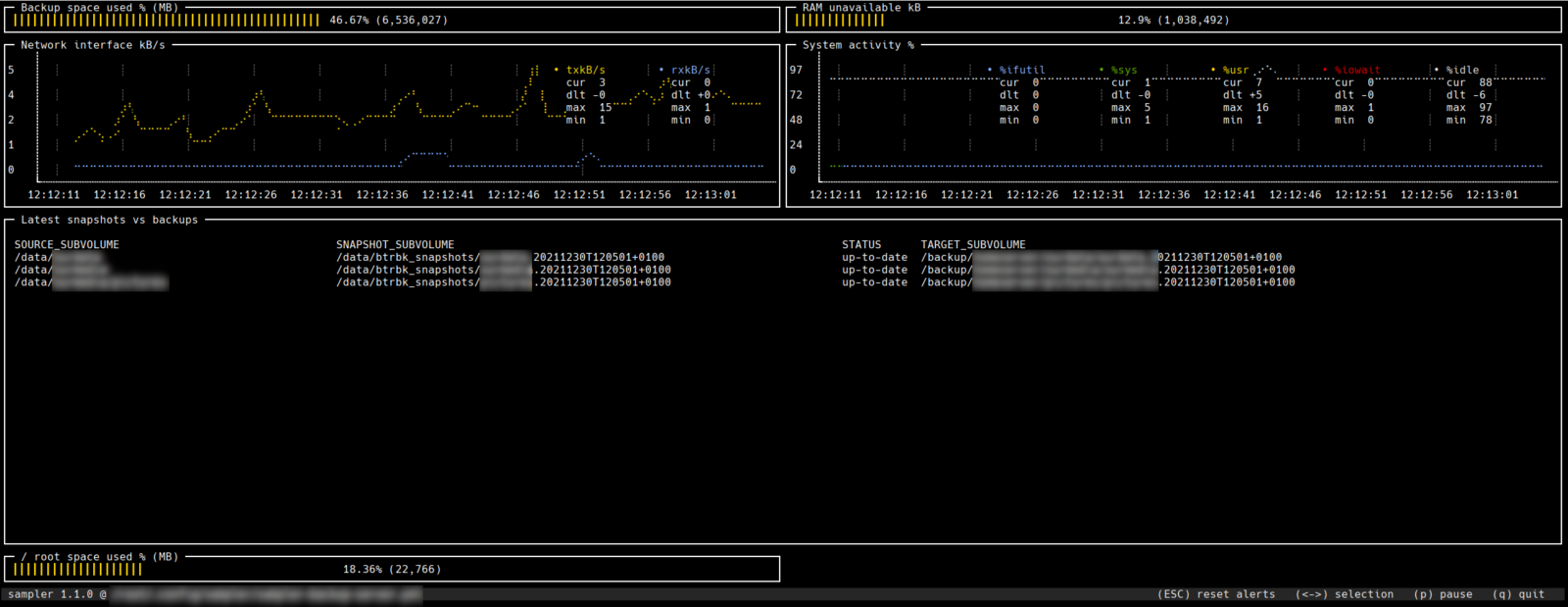A basic sampler dashboard definition for monitoring a hardened backup server on a terminal.
Special requirements:
- btrbk, configured to backup snapshots
- sampler
sarsystat(only thesarexecutable is required, it is safe to disable thesysstatservice after installation)
The configuration file defines a 80 columns x 40 rows basic console dashboard for a backup server that uses a btrfs volume for backups, and btrbk to orchestrate the backup process. To configure the dashboard, adjust the variables at the top of the script.

How to display the dashboard, after logging in to the backup server:
sampler --config sampler-backup-server.ymlYou’ll most likely want to use its sister script sampler-file-server.yml, on the file server.
variables:
# Configure these:
btrbk_config: "/etc/btrbk-backup-fileserver.conf"
mountpoint_backup: "/backup"
network_interface: "eno1"
tmp_dir: "/tmp"
max_backup_usage_percent: 80 # before visual alert
max_root_usage_percent: 66 # before visual alert
# Positions within 80x40 grid
# Colors: https://www.ditig.com/256-colors-cheat-sheet
textboxes:
- title: "Latest snapshots vs backups"
position: [[0, 15], [80, 23]]
rate-ms: 60000
sample: btrbk -c $btrbk_config --format=table list latest
- title: systemdummy # never displayed, just for collecting data
position: [[1000, 1000], [0, 0]]
rate-ms: 983
sample: LC_ALL= LC_TIME="en_DK" sar 1 1 -u ALL | tail -n 1 | tee "$tmp_dir/sarsys.tmp"
- title: networkdummy # never displayed, just for collecting data
position: [[1000, 1000], [0, 0]]
rate-ms: 983
sample: LC_ALL= LC_TIME="en_DK" sar 1 1 -n DEV --iface=$network_interface | tail -n 1 | tee "$tmp_dir/sarnet.tmp"
gauges:
- title: "Backup space used % (MB)"
position: [[0, 0], [40, 3]]
rate-ms: 5000
scale: 2
percent-only: false
color: 220
# variables unavailable in trigger conditions, workaround via name pipe
init: mkfifo backupvolume
cur:
sample: df --block-size=1000000 --output=used /backup | sed -e 1d -e 's/[^0-9]//g'
max:
sample: df --block-size=1000000 --output=size $mountpoint_backup | sed -e 1d -e 's/[^0-9]//g'
min:
sample: echo "$max_backup_usage_percent $mountpoint_backup" > backupvolume && echo 0
triggers:
- title: "Backup FS running out of space"
# Pull mountpoint and max usage from named pipe, since variables are unsupported in conditions
condition: BACKUP=$(cat < backupvolume) && BACKUPMOUNT=$(echo $BACKUP | cut -f2- -d' ') && BACKUPUSAGE=$(echo $BACKUP | cut -f1 -d' ') && echo "$(df --block-size=1000000 --output=used ${BACKUPMOUNT} | sed -e 1d -e 's/[^0-9]//g') * 100 / $(df --block-size=1000000 --output=size ${BACKUPMOUNT} | sed -e 1d -e 's/[^0-9]//g') >= $BACKUPUSAGE" | bc -l
actions:
visual: true
- title: "RAM unavailable kB"
position: [[40, 0], [40, 3]]
rate-ms: 2000
scale: 2
percent-only: false
color: 220
cur:
sample: awk '/MemAvailable/{available=$2} /MemTotal/{total=$2} END{print (total-available)}' /proc/meminfo
max:
sample: awk '/MemTotal/{total=$2} END{print (total)}' /proc/meminfo
min:
sample: echo 0
- title: "/ root space used % (MB)"
position: [[0, 38], [40, 3]]
rate-ms: 5000
scale: 2
percent-only: false
color: 220
# variables unavailable in trigger conditions, workaround via name pipe
init: mkfifo rootusage
cur:
sample: df --block-size=1000000 --output=used / | sed -e 1d -e 's/[^0-9]//g'
max:
sample: df --block-size=1000000 --output=size / | sed -e 1d -e 's/[^0-9]//g'
min:
sample: echo $max_root_usage_percent > rootusage && echo 0
triggers:
- title: "/ running out of space"
condition: ROOTUSAGE=$(cat < rootusage) && echo "$(df --block-size=1000000 --output=used / | sed -e 1d -e 's/[^0-9]//g') * 100 / $(df --block-size=1000000 --output=size / | sed -e 1d -e 's/[^0-9]//g') >= $ROOTUSAGE" | bc -l
actions:
visual: true
runcharts:
- title: "Network interface kB/s"
position: [[0, 3], [40, 12]]
rate-ms: 997 # slight offset to dummy data collector
scale: 0
legend:
enabled: true
details: true
items:
- label: "rxkB/s"
color: 111
sample: awk '{print $5}' "$tmp_dir/sarnet.tmp"
- label: "txkB/s"
color: 220
sample: awk '{print $6}' "$tmp_dir/sarnet.tmp"
- title: "System activity %"
position: [[40, 3], [40, 12]]
rate-ms: 997 # slight offset to dummy data collector
scale: 0
legend:
enabled: true
details: true
items:
- label: "%idle"
color: 254
sample: awk '/all/{print $12}' "$tmp_dir/sarsys.tmp"
- label: "%iowait"
color: 160
sample: awk '/all/{print $6}' "$tmp_dir/sarsys.tmp"
- label: "%usr"
color: 220
sample: awk '/all/{print $3}' "$tmp_dir/sarsys.tmp"
- label: "%sys"
color: 70
sample: awk '/all/{print $5}' "$tmp_dir/sarsys.tmp"
- label: "%ifutil"
color: 111
sample: awk '{print $10}' "$tmp_dir/sarnet.tmp"Image Credits:
Papirus icon for Terminal (modified) | GNU General Public License, version 3▫ Basic sampler dashboard for a backup server | by Rolf F. Katzenberger | Licensed under Creative Commons Attribution-ShareAlike 4.0 International (CC BY-SA 4.0)
Licensing:
This content is licensed under a Creative Commons Attribution-ShareAlike 4.0 International License.
For your attributions to us please use the word »tuxwise«, and the link https://tuxwise.net.
